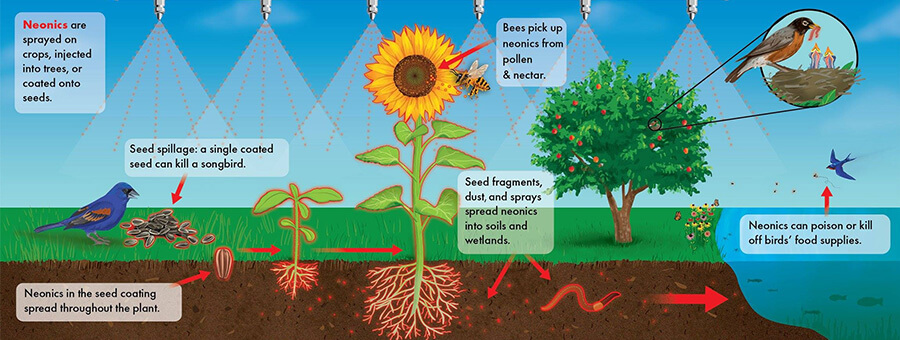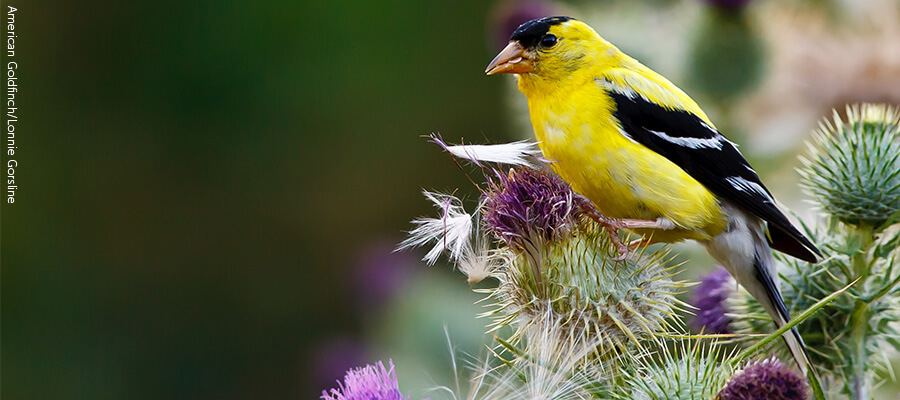The nation's most widely used insecticides, called neonicotinoids or “neonics,” are lethal to birds and to the insects that birds consume. First introduced in the United States in 1994, these pesticides are found in hundreds of products including insect sprays, seed treatments, soil drenches, tree injections, and veterinary ointments to control fleas in dogs and cats.
Neonicotinoids are “systemic” in plants. Unlike other pesticides that remain on the surface of treated foliage, these pesticides are taken up by the plant and transported to all tissues – including the leaves, flowers, roots and stems, as well as pollen and nectar.
Neonicotinoids have the potential to affect entire food chains. They are persistent in the environment, infiltrate groundwater, and have cumulative and largely irreversible effects on invertebrates. That means that neonics are harming the diverse wildlife that pollinates our crops and controls our pests for free.
Beneficial terrestrial invertebrates such as earthworms are killed by the neonicotinoids at extremely low doses. And the recently updated Worldwide Integrated Assessment documents the effects on fish, reptiles, frogs, birds, and mammals, including their negative impacts on growth, reproduction, and neurobehavior.
Neonics are Deadly to Birds
As our 2013 report revealed, neonics are toxic to birds and invertebrates, even in small quantities. ABC's review of 200 studies, including 2,800 pages of industry research obtained under the Freedom of Information Act (FOIA), concluded that a single seed treated with neonics is enough to kill a songbird. Lesser amounts can emaciate the birds, impair reproduction, and disrupt their migratory pathways.
Demonstrating these impacts in a study recently published in the journal Nature, world-renowned Canadian researchers studied White-crowned Sparrows during spring migration. Some birds were fed tiny neonicotinoid-treated canola seeds; others were given granules of chlorpyrifos (another pesticide known to be deadly to birds). All birds suffered significantly impaired orientation; in addition, the neonicotinoid-dosed birds lost up to one-quarter of their fat stores and body mass.

Our 2013 report also looked at aquatic insects, which are a critical food source for aerial insectivores — swifts, swallows, and other insect-eating birds that are now in decline. We found that levels of these chemicals in many surface and ground waters are enough to kill the aquatic invertebrate life on which insect-eating species depend, including birds such as the Common Nighthawk and Purple Martin.
Researchers in the Netherlands found that bird population trends were consistently more negative in areas with higher surface-water concentrations of the neonicotinoid imidacloprid. And a new study from Germany suggests that global insect populations are crashing as well, and that pesticides may be responsible. Additional research is underway.
Neonics are Bad for People, Too
Neonicotinoids are pervasive in our food supply. A 2015 study by ABC and the Harvard School of Public Health found neonics in more than 90 percent of food samples tested from Congressional dining halls. Most foods contained multiple different neonicotinoids, with up to five types detected in fresh-squeezed orange juice and green bell peppers.

In addition, animal studies have identified liver tumors in male rats, including statistically significant adenoma/carcinomas and rare cholangio-cellular carcinomas – cancers that are very aggressive and often deadly in humans.
Neonics in Your Yard
Unfortunately, many of us may be unknowingly using neonic-contaminated plants in our own gardens. ABC collaborated on a Friends of the Earth study that found that more than half of the seedlings purchased at Lowe's and other retailers contain neonics.
Many home and garden products – such as grub and insect killers and “weed and feed” products – also contain neonics. (Here's an easy-to-use list of products containing neonics.) Alarmingly, the concentration of neonics in products sold for residential use on ornamental plants are as much as 30 times what's allowed in the agricultural sector.

Neonics Poison Fields and Don't Increase Yields
Neonics are used in high concentrations in the coatings of seeds used to grow corn, canola, sunflowers, soy, other vegetables, and more. For many products such as corn, it's nearly impossible for farmers to buy seeds that are not treated.
Used as a pre-emptive strike, the neonicotinoid seed treatments are absorbed throughout the plant and persist through weather and washing. Independent scientists as well as government experts have found that neonicotinoid seed treatments' impact on agricultural productivity is marginal at best. These seed treatments do not provide a consistent return on investment, and by disrupting biological systems, they can even result in poorer yields than crops grown without neonicotinoids.

Say No to Neonics
In Canada and within the European Union, governments are taking decisive action to limit or even ban the use of neonics. Fortunately, some entities within the United States are beginning to take steps as well.
For example, the U.S. Fish and Wildlife Service issued a national policy decision phasing out the use of neonicotinoids on federal wildlife refuge lands nationwide by January 2016. ABC is now working to ban neonicotinoids on state refuge lands as well, beginning with our petition to the California Fish and Game Commission.
Some local U.S. jurisdictions have also taken action to limit use of neonics. Meanwhile, we can all help to reduce the prevalence of neonics and their impacts on birds and other wildlife:
• Buy organic fruits and vegetables when available and affordable.
• Choose plantings that are labeled organic or neonic-free. Ask your local nursery to stop selling neonic pesticides and treated plants.
• Avoid treating your garden with neonic products. (Here's a list to help guide your choices.)
• Share ABC's Birds and Neonic-Coated Seeds factsheet with friends and family.
• Never use pet collars that contain neonicotinoids, which are dangerous to children.
• Speak out: Tell the EPA and Congress that it's time to get serious about neonics.